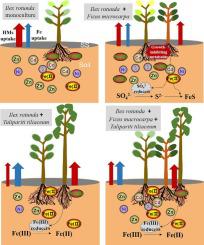Science of the Total Environment ( IF 8.2 ) Pub Date : 2023-05-14 , DOI: 10.1016/j.scitotenv.2023.164042 Daoming Wu 1 , Xiaoli Yu 2 , Sining Su 3 , Xiaoquan Dong 1 , Jiayi Feng 1 , Shucai Zeng 1

|
Heavy metals (HMs)-induced iron (Fe) deficiency severely inhibits plant growth and thus hampers phytoremediation and revegetation in HMs-contaminated soil. We conducted a 12-month pot experiment to investigate the effects and mechanisms of co-planting on altering plant HM-induced Fe deficiency. The landscape tree Ilex rotunda was co-planted with Ficus microcarpa and Talipariti tiliaceum in sludge-amended soil. The responses of I. rotunda growth, elements uptake, and rhizosphere microbial community and metabolites were analyzed. The addition of sludge increased cadmium (Cd), zinc (Zn), and nickel (Ni) uptake and induced Fe deficiency-induced chlorosis in I. rotunda. This chlorosis was exacerbated when I. rotunda was co-planted with F. macrocarpa due to the increase in the abundance of sulfate reduction or Fe immobilization-associated bacteria and the relative level of isoprenyl alcohol and atropine in I. rotunda rhizosphere but the decrease in the contents of soil diethylenetriaminepentaacetic acid Fe (DTPA-Fe) (−16.19 %). Co-planting with T. tiliaceum or F. macrocarpa and T. tiliaceum decreased the contents of total or DTPA Zn/Cd/Ni in the soil while increased the contents of soil DTPA-Fe by 13.24 % or 11.34 % and the abundance of microbes which contributed to immobilizing HMs or activating Fe reduction, and then alleviated the chlorosis and the growth inhibition of I. rotunda. These results provide a new perspective on the phytoremediation and revegetation of HMs-contaminated soil.















































 京公网安备 11010802027423号
京公网安备 11010802027423号